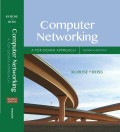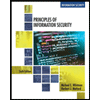
EBK COMPUTER NETWORKING
7th Edition
ISBN: 8220102955479
Author: Ross
Publisher: PEARSON
expand_more
expand_more
format_list_bulleted
Question
Chapter 1, Problem R20RQ
Program Plan Intro
End System:
End systems are the computer systems used for communicating with the required information over the network. As the name suggests, these computer systems are placed at the edge of the network. The user interacts or communicates through the end systems are termed as end users.
Packet switching:
Packet switched network is a process of aggregating the data packets to a single packet or device over the digital network. The data packet has a header which defines about the hardware used and a payload which is used in software applications.
Expert Solution & Answer
Trending nowThis is a popular solution!

Students have asked these similar questions
Suppose end system A wants to send a large file to end system B. At a very high level, describe how end system A creates packets from the file. When one of these packets arrives to a router, what information in the packet does the router use to determine the link onto which the packet is forwarded? Why is packet switching in the Internet analogous to driving from one city to another and asking directions along the way?
A packet switch receives a packet and determines the outbound link to which the packet should be forwarded. When the packet arrives, one other packet is halfway done being transmitted on this outbound link and four other packets are waiting to be transmitted. Packets are transmitted in order of arrival. Suppose all packets are 1,500 bytes and the link rate is 2 Mbps. What is the queuing delay for the packet? More generally, what is the queuing delay when all packets have length L, the transmission rate is R, x bits of the currently-being-transmitted packet have been transmitted, and n packets are already in the queue?
1. What is the difference between packet fragmentation (i.e., at network layer) and frame frag-
mentation (i.e., at link layer) in terms of purpose?
2. Suppose that host A is connected to a router R1, R1 is connected to another router, R2, and
R2 is connected to host B. Suppose that a TCP message that contains 800 bytes of data and
20 bytes of TCP header is passed to the IP function at host A for delivery to B. Show the
Total length, DF, MF, and Fragment offset fields of the IP header in each packet transmitted
over the three links. (Assume that link A-R1 can support a maximum frame size of 1024
bytes including a 14-byte frame header, link R1-R2 can support a maximum frame size of 512
bytes, including an 8-byte frame header, and link R2-B can support a maximum frame size
of 432 bytes including a 12-byte frame header.)
(*hint: the Fragment offset field is denominated by 8-bytes, not bytes)
3. What is the purpose of the path MTU discovery process (see textbook Figure 5-42) and why
does…
Chapter 1 Solutions
EBK COMPUTER NETWORKING
Ch. 1 - What is the difference between a host and an end...Ch. 1 - The word protocol is often used to describe...Ch. 1 - Why are standards important for protocols?Ch. 1 - Prob. R4RQCh. 1 - Prob. R5RQCh. 1 - Prob. R6RQCh. 1 - Prob. R7RQCh. 1 - Prob. R8RQCh. 1 - Prob. R9RQCh. 1 - Prob. R10RQ
Ch. 1 - Prob. R11RQCh. 1 - What advantage does a circuit-switched network...Ch. 1 - Prob. R13RQCh. 1 - Prob. R14RQCh. 1 - Prob. R15RQCh. 1 - Prob. R16RQCh. 1 - Prob. R17RQCh. 1 - Prob. R18RQCh. 1 - Suppose Host A wants to send a large file to Host...Ch. 1 - Prob. R20RQCh. 1 - Prob. R21RQCh. 1 - Prob. R22RQCh. 1 - What are the five layers in the Internet protocol...Ch. 1 - Prob. R24RQCh. 1 - Prob. R25RQCh. 1 - Prob. R26RQCh. 1 - Prob. R27RQCh. 1 - Prob. R28RQCh. 1 - Equation 1.1 gives a formula for the end-to-end...Ch. 1 - Prob. P3PCh. 1 - Prob. P4PCh. 1 - Prob. P5PCh. 1 - This elementary problem begins to explore...Ch. 1 - Prob. P7PCh. 1 - Suppose users share a 3 Mbps link. Also suppose...Ch. 1 - Prob. P9PCh. 1 - Prob. P10PCh. 1 - In the above problem, suppose R1 = R2 = R3 = R and...Ch. 1 - Prob. P13PCh. 1 - Consider the queuing delay in a router buffer. Let...Ch. 1 - Prob. P15PCh. 1 - Prob. P16PCh. 1 - Prob. P17PCh. 1 - Prob. P20PCh. 1 - Prob. P21PCh. 1 - Prob. P22PCh. 1 - Prob. P23PCh. 1 - Prob. P24PCh. 1 - Prob. P25PCh. 1 - Prob. P26PCh. 1 - Prob. P27PCh. 1 - Prob. P28PCh. 1 - Prob. P29PCh. 1 - Prob. P30PCh. 1 - Prob. P31PCh. 1 - Prob. P32PCh. 1 - Prob. P33PCh. 1 - Prob. P34P
Knowledge Booster
Similar questions
- It is theoretically feasible for two hosts to communicate with one another by sending packets back and forth over the same connection. Please enumerate all of the components that are responsible for the overall amount of time required to process a single packet, starting to end. Is it to be anticipated that one of the delays will continue for a certain amount of time, while the duration of the other delay will be more unpredictable?arrow_forwardA link between two hosts may carry many packets at once. Please give a timetable outlining all the tasks that must be completed to complete one shipment. Is it believed that one delay will take a fixed length of time while the other delay's duration may be modified as needed?arrow_forwardSuppose host A is sending a large file to host B over a TCP connection. The two end hosts are 10 msec apart (20 msec RTT) connected by a 1 Gbps link. Assume that they are using a packet size of 1000 bytes to transmit the file. For simplicity, ignore ack packets. At least how big would the window size (in packets) have to be for the channel utilization to be greater than 80%?arrow_forward
- R6Fragmentation of an IP datagram takes place if its size is larger than the MTU of the subnet over which the datagram will be routed. Most IP datagram reassembly algorithms have a timer to avoid having a lost fragment tie up reassembly buffers forever. Suppose a datagram is fragmented into four fragments. The first three fragments arrive, but the last one is delayed. Eventually the timer goes off and the three fragments in the receiver's memory are discarded. A little later, the last fragment stumbles in. What should be done with it?arrow_forwardA connection between two hosts is capable of carrying several packets at the same time. I would appreciate it if you could provide a schedule that details all of the activities that need to be completed in order to finish one shipment. Is it anticipated that one delay would last for a certain amount of time, whilst the other delay's length may be adjusted according to the circumstances?arrow_forwardSuppose a computer sends a frame to another computer on a bus topology LAN. The physical destination address of the frame is corrupted during the transmission. What happens to the frame? How can the sender be informed about the situation? Suppose a computer sends a packet at the network layer to another computer somewhere in the Internet. The logical destination address of the packet is cor- rupted. What happens to the packet? How can the source computer be informed of the situation?arrow_forward
- DNS makes use of UDP rather than TCP. If a DNS packet is dropped, there is no way to recover automatically. Is this a problem, and if so, how does one go about resolving it?arrow_forwardA connection between two hosts may support the transmission of several packets. Detailed instructions for completing a single shipment would be much appreciated. Is it assumed that one of the delays would take a fixed period of time and the other delay's length will vary with circumstances?arrow_forwardWhat exactly is the difference between forwarding and routing when it comes to routing operations?arrow_forward
- Consider a short, 10-meter link, over which a sender can transmit at a rate of 150 bits/sec in both directions. Suppose that packets containing data are 100,000 bits long, and packets containing only control (e.g., ACK or handshaking) are 200 bits long. Assume that N parallel connections each get 1/N of the link bandwidth. Now consider the HTTP protocol, and suppose that each downloaded object is 100 Kbits long, and that the initial downloaded object contains 10 referenced objects from the same sender. Would parallel downloads via parallel instances of non-persistent HTTP make sense in this case? Now consider persistent HTTP. Do you expect significant gains over the non-persistent case? Justify and explain your answerarrow_forward3. Consider a simple application-level protocol built on top of UDP that allows a client to retrieve a file from a remote server residing at a well-known address. The client first sends a request with a file name, and the server responds with a sequence of data packets containing different parts of the requested file. To ensure reliability and sequenced delivery, client and server use a stop-and-wait protocol. Ignoring the obvious performance issue, do you see a problem with this protocol? Think carefully about the possibility of processing crashing. State conclusion: Provide Proof: Solution:arrow_forward10. Suppose a computer sends a frame to another computer on a bus topology LAN. The physical destination address of the frame is corrupted during the transmission. What happens to the frame? How can the sender be informed about the situation? 11. Suppose a computer sends a packet at the network layer to another computer somewhere in the Internet. The logical destination address of the packet is corrupted. What happens to the packet? How can the source computer be informed of the situation? 12. Suppose a computer sends a packet at the transport layer to another computer somewhere in the Internet. There is no process with the destination port address running at the destination computer. What will happen? 13. If the data link layer can detect errors between hops, why do you think we need another checking mechanism at the transport layer?arrow_forward
arrow_back_ios
SEE MORE QUESTIONS
arrow_forward_ios
Recommended textbooks for you
 A+ Guide To It Technical SupportComputer ScienceISBN:9780357108291Author:ANDREWS, Jean.Publisher:Cengage,
A+ Guide To It Technical SupportComputer ScienceISBN:9780357108291Author:ANDREWS, Jean.Publisher:Cengage, Principles of Information Security (MindTap Cours...Computer ScienceISBN:9781337102063Author:Michael E. Whitman, Herbert J. MattordPublisher:Cengage Learning
Principles of Information Security (MindTap Cours...Computer ScienceISBN:9781337102063Author:Michael E. Whitman, Herbert J. MattordPublisher:Cengage Learning Systems ArchitectureComputer ScienceISBN:9781305080195Author:Stephen D. BurdPublisher:Cengage Learning
Systems ArchitectureComputer ScienceISBN:9781305080195Author:Stephen D. BurdPublisher:Cengage Learning

A+ Guide To It Technical Support
Computer Science
ISBN:9780357108291
Author:ANDREWS, Jean.
Publisher:Cengage,

Principles of Information Security (MindTap Cours...
Computer Science
ISBN:9781337102063
Author:Michael E. Whitman, Herbert J. Mattord
Publisher:Cengage Learning

Systems Architecture
Computer Science
ISBN:9781305080195
Author:Stephen D. Burd
Publisher:Cengage Learning